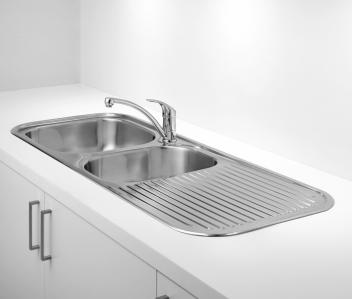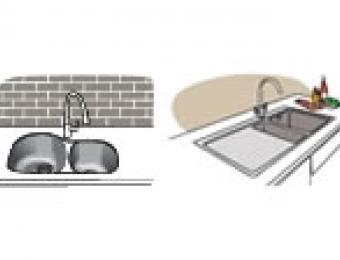
The most common of all kitchen sink materials is stainless steel - and with good reason. It's cost effective, usable, durable, can be made into all kinds of shapes and configurations, and it's hygienic and easy to clean.
Stainless steel sinks can be moulded and shaped to fit just about any need, and often come with drainboards designed into the sink.
Types and properties of stainless steel
'Stainless steel', firstly, is a highly corrosion resistant material that we're all pretty familiar with. Rather than being a single metal, stainless steel is made from a combination of alloys, normally incorporating iron (steel), chromium (which gives it its corrosion resistance), and nickel which makes it more malleable and ductile. The 'stainless' part of stainless steel comes as the chromium creates an extremely thin and self-healing chromium oxide barrier on the surfaces of the material.
Without going into specifics, different types and grades of stainless steel contain different compositions of alloys, and have different metallic structures and properties. A typical kitchen sink might be made of Type 304 or Type 302 stainless steel.
Gauges of stainless steel sinks
Stainless steel sinks come in a variety of 'gauges' - these are a measure of the thickness of the sink walls. It's best to select a mid- to heavy-gauge sink to ensure that the sink holds its heat, resists dents, and offers a reasonable amount of soundproofing. A heavier gauge will generally be sturdier and quieter, although this also depends in part on the design. Domestic kitchen sinks are generally available in 18 or 20 gauge, with 18 being the heavier of the two. Sinks for commercial kitchens may use thicker 16 or 14 gauge steel.
Many stainless steel sinks are also coated on the underside with a layer of vibration restricting material like latex to reduce noise and heat transfer, and to prevent condensation.
How are stainless steel sinks made?
The uncomplicated answer is that stainless steel sinks are made by drawing a sheet of stainless steel over a die where it's then pressed into the required shape, after which holes are punched for drains and taps. There are several variations to this process though. If the sink needs to be deeper than normal, for example, it may have to be fabricated by welding.
Stainless steel can come with a number of different finishes, including a brushed metal or polished look. These finishes are normally applied to the finished product either by machining or by hand. Other finishes include antique, copper, hammered and weathered. Choosing the right one will depend on the style of your kitchen, and how well the sink suits the particular style of kitchen you're after. Keep in mind that a shiny satin finish is likely to lose a bit of its lustre with wear.
|
Advantages
|
Disadvantages
|


